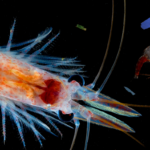Animal survival strategies in Neoproterozoic ice worlds
1 January, 2023 by Huw Griffiths, Rowan Whittle
The timing of the first appearance of animals is of crucial importance for understanding the evolution of life on Earth. Although the fossil record places the earliest metazoans at 572–602 Ma,…Read more on Animal survival strategies in Neoproterozoic ice worlds
